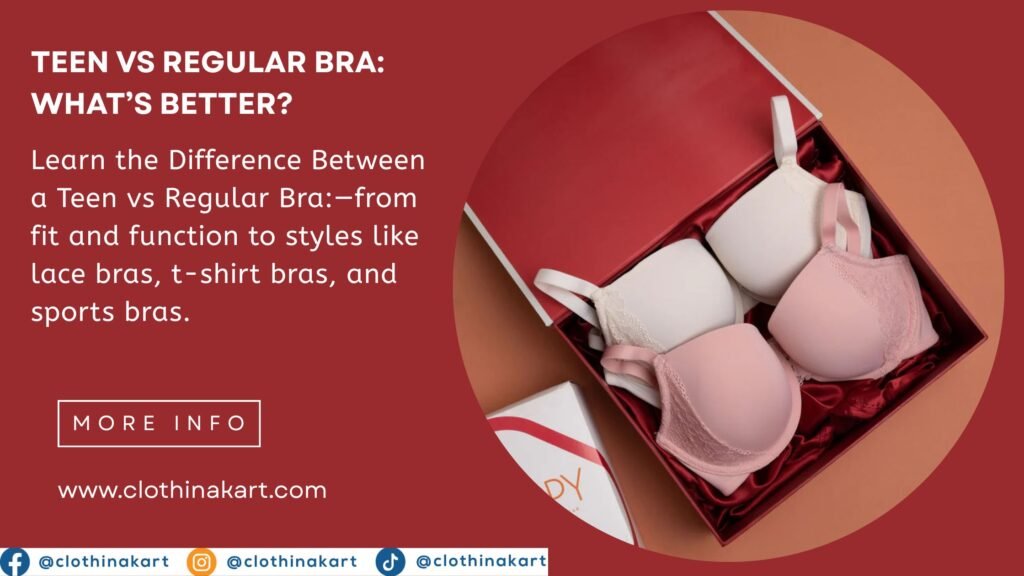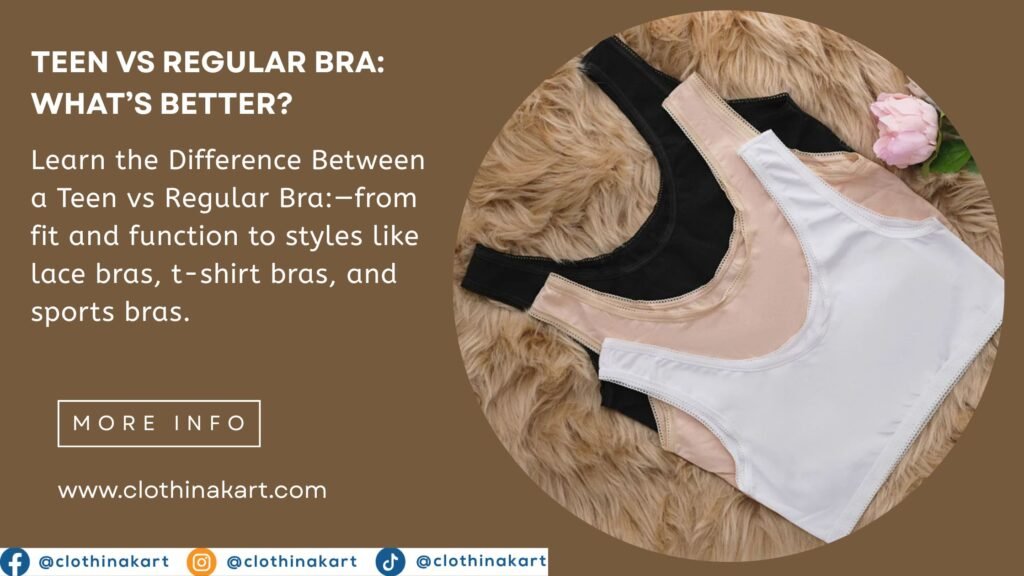Bra Guides
Teen vs Regular bra: What’s Better?
Introduction
Did you know that around 80–85% of women in the U.S. wear the wrong-sized bra?¹ It’s not just about size—choosing the right type is crucial, especially for teens. That’s why today we’re exploring the Difference Between a Teen vs Regular bra. In fact, a recent survey shows that 84% of girls feel self-conscious during puberty²—and with the right teen bra, confidence can soar. So, whether you’re shopping for yourself or your daughter, stick around to discover key differences, top products, and how to choose the best.
Shop Now
🧠 What’s the Difference Between a Teenager Bra and a Regular Bra?
Both teen bras (aka training or beginner bras) and regular bras offer support, but they differ significantly:
| Feature | Teenager Bra | Regular Bra |
|---|---|---|
| Purpose | Designed for budding breasts, offering light support | Designed for mature breasts, offering structured support |
| Structure | Wire-free, soft cups or no cups, elastic underbust band | Underwire or structured cups, adjustable closures |
| Closure | Slip-on or simple hook-less back | Back-hooks (usually 2–4) |
| Straps | Often fixed or minimally adjustable | Fully adjustable straps |
| Padding & Cups | Minimal or no padding; sometimes uni-boob style | Defined cups, padded or unpadded |
| Fabric | Cotton or stretch fabrics only | Variety (cotton, lace, satin, microfiber) |
| Sizing | General sizes (S/M/L) or small band + small cup | Precise sizes (e.g. 34B, 36C) |
| Support Level | Gentle support to ease into wearing a bra | Robust support for daily use, sports, etc. |
The Difference Between a Teenager Bra and a Regular Bra lies primarily in support level, structure, and design—teen bras are soft, wire-free comfort when growth is just beginning, while regular bras offer more shape, structure, and refined sizing.
Top Teen & Regular Bras: In‑Depth Reviews
1. Brand A Teen Training Bra (Cotton Slip‑On)
Pros: Soft, breathable cotton; easy slip-on; no wires—great for first-time wear.
Cons: No structure—won’t offer lift for larger or more developed breasts.
Why it matters: Perfect introduction to bra wearing—light, comfy, and confidence-boosting.
2. Brand B Lace Bralette (Teen-Friendly)
Pros: Stylish lace design with soft lining; wire-free but shaped.
Cons: Lace can itch; limited color options.
Highlights: Bridges the gap between training bras and regular lace bras.
3. Brand C Underwire T-Shirt Bra
Pros: Smooth molding under tees; underwire support; light padding.
Cons: Not suitable for teens—too much structure too soon.
Why include: Demonstrates how regular bras offer significantly more shape and separation.
4. Brand D Push-Up Regular Bra
Pros: Extra lift and cleavage; stylish straps and detailing.
Cons: Too much exaggeration and padding for teenage use.
5. Brand E Minimizer Bra
Pros: Minimizes bust volume visually; full coverage.
Cons: Can feel tight/uncomfortable—primarily an adult option.
6. Brand F Sports Bra (Low‑Impact)
Pros: Great for teenage physical activity; moisture-wicking.
Cons: Not enough for high-impact sports for teens with developing busts.
7. Brand G Padded T‑Shirt Bra
Pros: Seamless look under clothes; light padding for modesty.
Cons: Teens may find structured wire poky.
Buyer’s Guide: Choosing the Right Bra
- Support & Comfort: For teens, soft, wire-free, and slip-on or hook-less designs are ideal.
- Growth Stage: If cups start gapping or underband rides up—time to upgrade.
- Occasion & Activity:
- Everyday teen: lightweight, cotton-bralettes or simple t-shirt bras.
- Sports: low-impact sports bras with moisture control.
- Adults: underwire, push-up or minimizer bras for shape and lift.
- Fabric & Care: Cotton and breathable microfiber are great for teens; lace and satin add elegance for regular use.
- Fit Accuracy: Teens usually need general sizing → S, M, L. Adults require professional measurement (band + cup).
- Feel & Confidence: Choose styles that feel good—and feel good to wear.
Bra Style Spotlight: Matching Needs to Styles
- Lace Bras: Beautiful and feminine but may be itchy for teens.
- Plunge Bras: Deep center—great for low-cut adult tops, not ideal for teens.
- Underwire Bras: Structured support—adult territory.
- Push-Up Bras: Lift and cleavage—mature audience.
- Minimizer Bras: Shape reducing—again, adult use.
- Sports Bras: Essential for both teens (low-impact) and adults (various impact levels).
- T-shirt Bras: Seamless comfort—good transitional bra.
- Padded Bras: Modesty padding—can be teen or adult depending on design.
🛍️ 5 FAQs on “Difference Between a Teenager Bra and a Regular Bra”
- When should a teenager switch to a regular bra?
When the underband rides up, cups gape or spill, or she fills a B-cup—confirmed fit signals time to upgrade³. - Are lace bras appropriate for teens?
Only if the lace is soft and lined; teen priority is comfort over decoration. - Can a teen wear padded bras?
Yes—light padding for modesty is fine, but avoid heavy foam or underwire until development stabilizes. - How often should bra size be measured?
Every 6 months during puberty; annually for adults, or when you notice fit issues⁴. - Is an underwire bra bad for teens?
Underwire isn’t harmful—but might feel heavy. Best to wait until breast growth stabilizes.
Final Thoughts
In short, the Difference Between a Teenager Bra and a Regular Bra is vital: the former is gentle, minimal, and comfortable for beginning development; the latter offers structure, lift, and precise fit for mature bodies. Always prioritize comfort and correct fit—and when in doubt, go simpler. Your body (or your teen’s) will thank you.

The Ultimate Guide to Push Up Bras: Comfort, Confidence, and Style
T-Shirt Bras: The Ultimate Guide to Comfort and Style
Be the Active Mom You Love – Sports Feeding Bra
Best Minimizer Bras That Lift, Support & Flatter – No Compromise!
Underwire Bras: The Ultimate Guide to Comfort, Support, and Style
Plunge Bras: The Ultimate Guide to Deep Neckline Confidence
Lace Bra Trends You’ll Love in 2025

